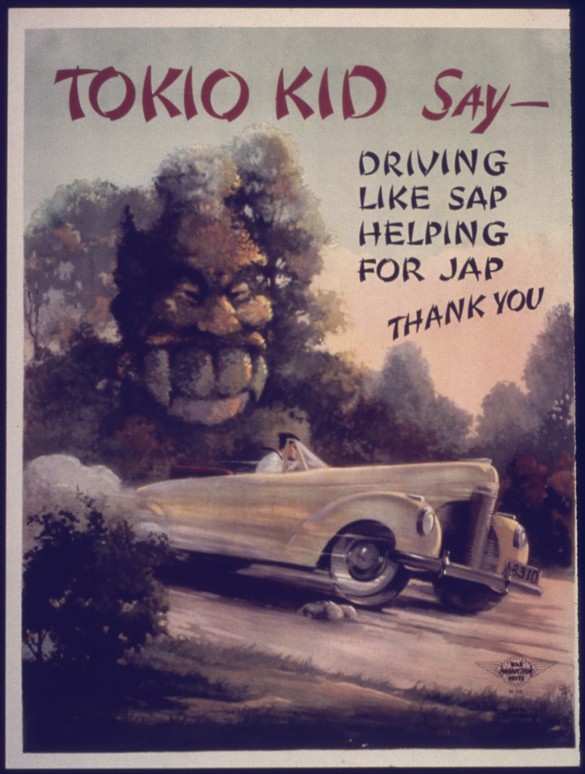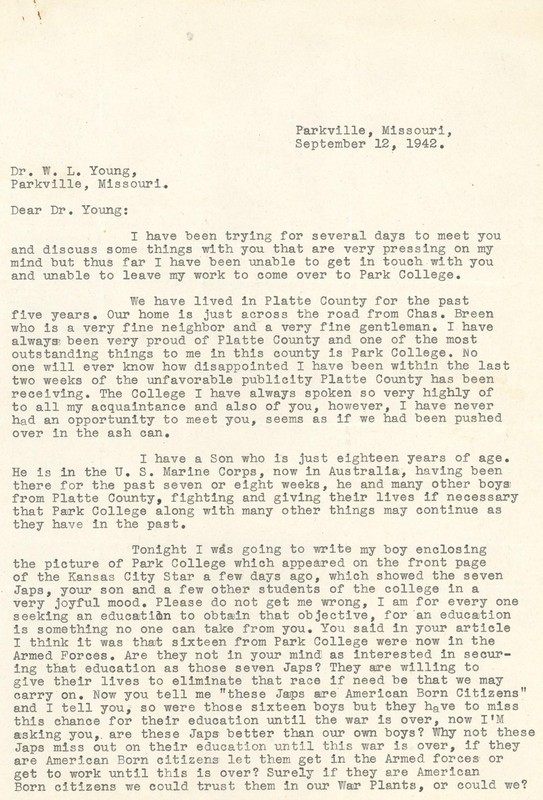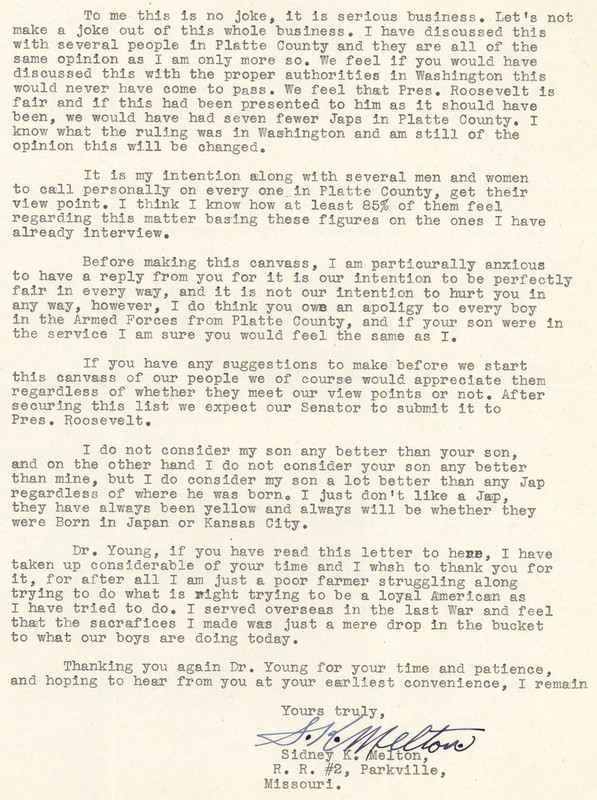Local Perspective reflects National Sentiments - Sidney K. Melton
Introduction
Text-to-speech Audio
The National Archives and Records Administration (NARA) houses World War II propaganda posters. The NARA Research Center in Washington, D.C., allows the public to view historic materials in-person. For those who cannot travel to the physical NARA locations around the country, many documents and artifacts are available digitally through the NARA online archives.
"Tokio Kid" was a recurring image depicting the Japanese during World War II. As Brandon Seto explains, the depictions of the Japanese in media allowed the American people to view the Japanese as inhuman threats that would not surrender until the United States fell (Seto 60). However, such depictions were based on encounters with the Japanese military, not civilians. Thus, American propaganda generalized the Japanese populace based on portrayals of military combatants. On top of this, the depictions further established the Japanese as inhuman or subhuman, further separating the Japanese from accurate depictions in American propaganda. The following "Tokio Kid" poster displays a vampiric figure, with large fangs and pointed ears, to represent the Japanese enemy. Improper English grammar is used when depicting the thoughts of "Tokio Kid," intended to mock Japanese accents. The appearance of "Tokio Kid" provided a completely inhuman character for Americans to project onto Japan, making later horrors that occurred against the Japanese easier to accept.
Melton's racially based agitation towards Japanese Americans and immigrants reflected sentiments held towards the Japanese perpetuated by propaganda efforts and long-held racial prejudice. Melton exclaims:
"I think it was that sixteen from Park College were now in the Armed Forces. Are they not in your mind as interested in securing that education as those seven Japs? They are willing to give their lives to eliminate that race if need be that we may carry on" (Sidney K. Melton, Sept. 12, 1942, Page 1).
Melton emphasizes how American forces would work towards the elimination of the Japanese if necessary, highlighting the call for eradication or extermination as pushed by previously featured propaganda posters. Such a view also reflects the dehumanization of the Japanese people, calling to mind the vampiric and inhuman appearance of the "Tokio Kid" caricature.
Melton continues, stating that:
"I do consider my son a lot better than any Jap, they have always been yellow and always will be whether they were Born in Japan or Kansas City" (Sidney K. Melton, Sept. 12, 1942, Page 2).
This statement reflects the ingrained ideas of assimilable versus unassimilable immigrants and Americans, demonstrating racial bias against those with Japanese heritage. Although Melton believed he was being a loyal American, even stating so in the final paragraph of his letter, he served as an example of permeating racial bias and hatred that intensified during the war.
Images
Propaganda poster depicting the caricature "Tokio Kid" to motivate Americans in the war efforts at home, 1941-45

Letter from Sidney K. Melton to Dr. William Lindsay Young in Opposition to Nisei students, Sept. 12, 1942, Page 1

Letter from Sidney K. Melton to Dr. William Lindsay Young in Opposition to Nisei students, Sept. 12, 1942, Page 2

Backstory and Context
Text-to-speech Audio
Sources
Daniels, Roger. Asian America: Chinese and Japanese in the United States Since 1850. [N.p.]: University of Washington Press, 2011.
Dower, John W. War without Mercy: Race and Power in the Pacific War. 1st ed. Pantheon Books, 1986.
Finch, Lynette. “Psychological Propaganda: The War of Ideas on Ideas During the First Half of the Twentieth Century.” Armed Forces & Society 26, no. 3 (Spring 2000): 367–86. doi:10.1177/0095327X0002600302.
Klein, Christina. Cold War Orientalism: Asia in the Middlebrow Imagination, 1945-1961. Berkeley: University of California Press, 2003.
Kurashige, Lon. Two Faces of Exclusion: The Untold History of Anti-Asian Racism in the United States. Chapel Hill: The University of North Carolina Press, 2016.
“Letter from Sidney Melton to Dr. Young,” letter from Sidney K. Melton to Dr. William Lindsay Young, Sept. 12, 1942, page 1. Located in Francis Fishburn Archives and Special Collections, Park University Nisei Collection, Park University, Parkville, MO, ID: PC-L-1942.1.704.
National Archives and Records Administration Collection; ddr-densho-37; 1940s; Courtesy of National Archives and Records Administration; Densho Digital Repository; https://ddr.densho.org/ddr-densho-37/.
Seto, Brandon P. “Paternalism and Peril: Shifting U.S. Racial Perceptions of the Japanese and Chinese Peoples from World War II to the Early Cold War.” Asia Pacific Perspectives 13, no. 1 (2015): 57–78.
World War II Posters, 1942-1945; Office for Emergency Management. Office of War Information. Domestic Operations Branch. Bureau of Special Services, Record Group 44; National Archives and Records Administration – College Park Region (Maryland). https://catalog.archives.gov/id/513498.
"Propaganda Poster: 'Tokio Kid Say,'" Densho Digital Repository, ID#: ddr-densho-37-500, Parent Collection: National Archives and Records Administration Collection. https://ddr.densho.org/ddr-densho-37-500/
“Letter from Sidney Melton to Dr. Young,” letter from Sidney K. Melton to Dr. William Lindsay Young, Sept. 12, 1942, page 1. Located in Francis Fishburn Archives and Special Collections, Park University Nisei Collection, Park University, Parkville, MO, ID: PC-L-1942.1.704. https://www.jstor.org/stable/community.32855065?searchText=PC-L-1942.1.704&searchUri=%2Faction%2FdoBasicSearch%3FQuery%3DPC-L-1942.1.704&ab_segments=0%2Fbasic_search_gsv2%2Fcontrol&refreqid=fastly-default%3Aaecefe3124af30f8ff767e7fb72703c9&searchkey=1681257716959
“Letter from Sidney Melton to Dr. Young,” letter from Sidney K. Melton to Dr. William Lindsay Young, Sept. 12, 1942, page 1. Located in Francis Fishburn Archives and Special Collections, Park University Nisei Collection, Park University, Parkville, MO, ID: PC-L-1942.1.704. https://www.jstor.org/stable/community.32855065?searchText=PC-L-1942.1.704&searchUri=%2Faction%2FdoBasicSearch%3FQuery%3DPC-L-1942.1.704&ab_segments=0%2Fbasic_search_gsv2%2Fcontrol&refreqid=fastly-default%3Aaecefe3124af30f8ff767e7fb72703c9&searchkey=1681257716959
